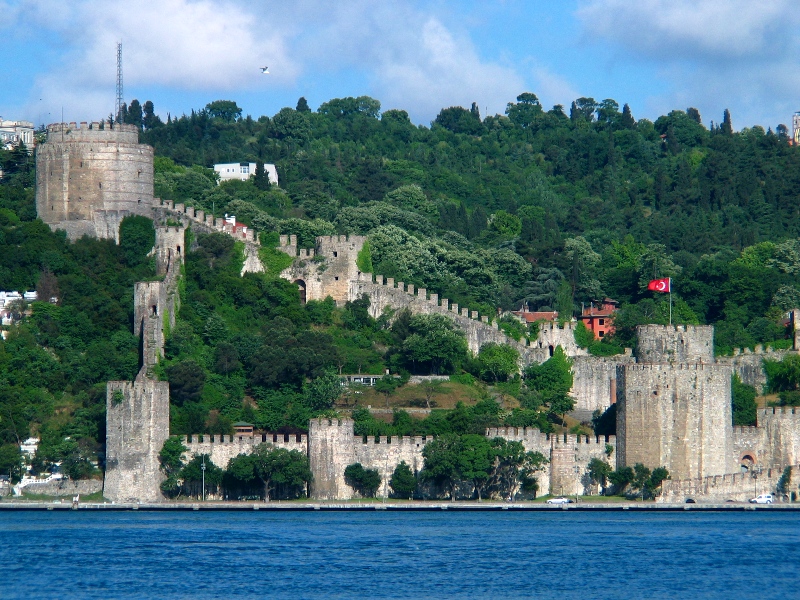Column of Constantine
History
The Column of Constantine in 1912
The column was dedicated on May 11, 330 AD, with a mix of Christian and pagan ceremonies.
In Constantine's day the column was at the center of the Forum of Constantine (today known as Çemberlitaş Square), an oval forum situated outside the city walls in the vicinity of what may have been the west gate of Antoninia. On its erection, the column was 50 meters tall, constructed of nine cylindrical porphyry blocks surmounted by a statue of Constantine in the figure of Apollo. The orb he carried was said to contain a fragment of the True Cross. At the foot of the column was a sanctuary which contained relics claimed to be from the crosses of the two thieves who were crucified with Jesus Christ at Calvary, the baskets from the loaves and fishes miracle, an alabaster ointment jar belonging to Mary Magdalene and presumably used by her for the washing of the feet of Jesus,[1] the palladium of ancient Rome a wooden statue of Pallas Athena from Troy.
A strong gale in 1106 AD caused the statue and three of the upper cylinders of the column to fall. Some years later, Byzantine emperor Manuel I Komnenos (reigned 1143-1180) placed a cross on top, in the place of the original statue, and added a commemorative inscription that read "Faithful Manuel invigorated this holy work of art which has been damaged by time." Bronze wreaths once covered the joints between the drums, but these were taken by the Latin Crusaders who looted the city during the Fourth Crusade in 1204. The cross was removed by the Ottoman Turks after the fall of Constantinople in 1453.[2]
Earthquakes and a fire in 1779 destroyed the neighborhood surrounding the column, leaving it with black scorch marks and earning it the name 'Burnt Column'. The column was restored by Abdülhamid I, who had the present masonry base added.[3] The base was strengthened in 1779. The original platform of the column is 2.5 meters below ground.
Tarih
Üstüne Apollo gibi Konstantin'in heykeli orijinal biçiminde Constantine Sütunu,
1912 yılında Konstantin Sütunu
Sütun Hıristiyan ve pagan törenlerini bir karışımı ile 11 Mayıs MS 330 üzerinde adanmıştır.
Constantinus'un gününde sütun Konstantin Forumu (bugün Çemberlitaş Meydanı olarak da bilinir), Antoninia batı kapısı olabilir ne çevresinde surların dışında yer alan oval bir forumun merkezinde idi. Onun ereksiyon, sütun Apollon şekilde Konstantin'in heykeli ile örtülmüştür dokuz silindirik porfir blokları inşa, 50 metre boyunda idi. O taşınan küre Gerçek Haç bir parçası içeren söyleniyordu. Sütunun dibinde emanetler Calvary de İsa ile birlikte çarmıha gerilen iki hırsız, somun ve balıklar mucize, Mecdelli Meryem ait bir alabaster merhem kavanoz sepet haçlar ait olduğu iddia edilen ve muhtemelen bulunan bir kutsal İsa'nın ayakların yıkanması için onun tarafından kullanılan, [1] Antik Roma paladyum Troy Pallas Athena ahşap bir heykel.
Güçlü bir fırtına 1106 AD heykeli ve sütunun üst silindir üç düşmesine neden oldu. Birkaç yıl sonra, Bizans İmparatoru I. Manuel Komnenos (1143-1180 hüküm) orijinal heykelinin yerine, üstüne bir haç yerleştirilmiş ve "Sadık Manuel tarafından tahrip olmuştur sanat bu kutsal çalışma canlandırdı okumak bir hatıra kitabesi eklendi zaman. " Bronz çelenk kez davul arasındaki eklemler kaplıdır, ama bu 1204 yılında Dördüncü Haçlı Seferi sırasında şehir yağmalandı Latin Haçlılar tarafından alınmıştır. Çapraz 1453 çöküşünden sonra Osmanlı Türkleri tarafından çıkarıldı. [2]
Depremler ve 1779 yılında bir yangın siyah yanık izleri ile bırakarak ve adı 'Yanık Sütun' kazanç, sütunun çevresindeki mahalle yıkıldı. Sütun mevcut kâgir tabanı eklemişti Abdülhamid tarafından restore edilmiştir. [3] üssü 1779 yılında güçlendirilmiştir. Sütunun özgün bir platform toprak altında 2,5 metre uzaklıktadır.








